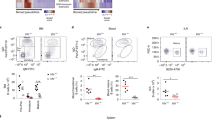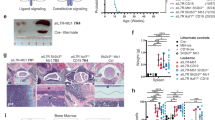Abstract
The homeobox (Hox) gene family encodes a group of transcription factors preferentially expressed during embryonic development and hematopoiesis. Deregulation of Hox gene expression is frequently associated with acute leukemia. HoxA9 is the most commonly overexpressed Hox gene in acute leukemia. However, little is known regarding specific pathways regulated by HoxA9 that promote the growth and survival of leukemic cells. We have generated a conditional model of HoxA9 activity in the stromal cell dependent, HoxA9 negative, pre-B-cell line B-lineage-2 (BLIN-2). Conditional HoxA9 activation in BLIN-2 resulted in increased proliferation in the presence and absence of stromal cell support. Stimulation of HoxA9 activity resulted in increased expression of the c-Myb transcription factor and induction of insulin-like growth factor-1 receptor (IGF-1R) surface expression. HoxA9-mediated proliferative effects in BLIN-2 cells were abrogated when the cells were treated with specific IGF-1R tyrosine kinase inhibitors or with an IGF-1R mAb (A12). IGF-1R expression correlated with endogenous HoxA9 expression in a small panel of mixed lineage leukemia (MLL)/AF4 cell lines. siRNA knockdown of endogenous HoxA9 expression in the MLL/AF4-positive cell line RS4;11 resulted in loss of IGF-1R expression. These data indicate that HoxA9 overexpression induces IGF-1R expression and subsequently promotes leukemic cell growth.
This is a preview of subscription content, access via your institution
Access options
Subscribe to this journal
Receive 12 print issues and online access
$259.00 per year
only $21.58 per issue
Buy this article
- Purchase on Springer Link
- Instant access to full article PDF
Prices may be subject to local taxes which are calculated during checkout








Similar content being viewed by others
References
Grier DG, Thompson A, Kwasniewska A, McGonigle GJ, Halliday HL, Lappin TR . The pathophysiology of HOX genes and their role in cancer. J Pathol 2005; 205: 154–171.
van Oostveen JW, Bijl J, Raaphorst F, Walboomers J, Meijer C . The role of homeobox genes in normal hematopoiesis and hematological malignancies. Leukemia 1999; 13: 1675–1690.
Shen WF, Rozenfeld S, Kwong A, Kom ves LG, Lawrence HJ, Largman C . HOXA9 forms triple complexes with PBX2 and MEIS1 in myeloid cells. Mol Cell Biol 1999; 19: 3051–3061.
Magli MC, Largman C, Lawrence HJ . Effects of HOX homeobox genes in blood cell differentiation. J Cell Physiol 1997; 173: 168–177.
Imamura T, Morimoto A, Takanashi M, Hibi S, Sugimoto T, Ishii E et al. Frequent co-expression of HoxA9 and Meis1 genes in infant acute lymphoblastic leukaemia with MLL rearrangement. Br J Haematol 2002; 119: 119–121.
Rozovskaia T, Feinstein E, Mor O, Foa R, Blechman J, Nakamura T et al. Upregulation of Meis1 and HoxA9 in acute lymphocytic leukemias with the t(4: 11) abnormality. Oncogene 2001; 20: 874–878.
Thorsteinsdottir U, Kroon E, Jerome L, Blasi F, Sauvageau G . Defining roles for HOX and MEIS1 genes in induction of acute myeloid leukemia. Mol Cell Biol 2001; 21: 224–234.
Kroon E, Krosl J, Thorsteinsdottir U, Baban S, Buchberg AM, Sauvageau G . Hoxa9 transforms primary bone marrow cells through specific collaboration with Meis1a but not Pbx1b. EMBO J 1998; 17: 3714–3725.
Dorsam ST, Ferrell CM, Dorsam GP, Derynck MK, Vijapurkar U, Khodabakhsh D et al. The transcriptome of the leukemogenic homeoprotein HOXA9 in human hematopoietic cells. Blood 2004; 103: 1676–1684.
Hu YL, Passegué E, Fong S, Largman C, Lawrence HJ . Evidence that the Pim1 kinase gene is a direct target of HOXA9. Blood 2007; 109: 4732–4738.
Bei L, Lu Y, Eklund EA . HOXA9 activates transcription of the gene encoding gp91Phox during myeloid differentiation. J Biol Chem 2005; 280: 12359–12370.
Ferrell CM, Dorsam ST, Ohta H, Humphries RK, Derynck MK, Haqq C et al. Activation of stem-cell specific genes by HOXA9 and HOXA10 homeodomain proteins in CD34+ human cord blood cells. Stem Cells 2005; 23: 644–655.
Shah N, Oseth L, LeBien TW . Development of a model for evaluating the interaction between human pre-B acute lymphoblastic leukemic cells and the bone marrow stromal cell microenvironment. Blood 1998; 92: 3817–3828.
Bertrand FE, Spengeman JD, Shah N, LeBien TW . B-cell development in the presence of the MLL/AF4 oncoprotein proceeds in the absence of HOXA7 and HOXA9 expression. Leukemia 2003; 17: 2454–2459.
Bertrand FE, Vogtenhuber C, Shah N, LeBien TW . Pro-B-cell to pre-B-cell development in B-lineage acute lymphoblastic leukemia expressing the MLL/AF4 fusion protein. Blood 2001; 98: 3398–3405.
Stong RC, Korsmeyer SJ, Parkin JL, Arthur DC, Kersey JH . Human acute leukemia cell line with the t(4;11) chromosomal rearrangement exhibits B lineage and monocytic characteristics. Blood 1985; 65: 21–31.
Greil J, Gramatzki M, Burger R, Marschalek R, Peltner M, Trautmann U et al. The acute lymphoblastic leukaemia cell line SEM with t(4;11) chromosomal rearrangement is biphenotypic and responsive to interleukin-7. Br J Haematol 1994; 86: 275–283.
Pui JC, Allman D, Xu L, DeRocco S, Karnell FG, Bakkour S et al. Notch1 expression in early lymphopoiesis influences B versus T lineage determination. Immunity 1999; 11: 299–308.
Littlewood TD, Hancock DC, Danielian PS, Parker MG, Evan GI . A modified oestrogen receptor ligand-binding domain as an improved switch for the regulation of heterologous proteins. Nucleic Acids Res 1995; 23: 1686–1690.
Samuels ML, Weber MJ, Bishop JM, McMahon M . Conditional transformation of cells and rapid activation of the mitogen-activated protein kinase cascade by an estradiol-dependent human raf-1 protein kinase. Mol Cell Biol 1993; 13: 6241–6252.
Sykes DB, Kamps MP . Estrogen-regulated conditional oncoproteins: tools to address open questions in normal myeloid cell function, normal myeloid differentiation, and the genetic basis of differentiation arrest in myeloid leukemia. Leuk Lymphoma 2003; 44: 1131–1139.
Stuart ET, Gruss P . PAX: developmental control genes in cell growth and differentiation. Cell Growth Differ 1996; 7: 405–412.
Hill MA, Schedlich L, Gunning P . Serum-induced signal transduction determines the peripheral location of beta-actin mRNA within the cell. J Cell Biol 1994; 126: 1221–1229.
Hess JL, Bittner CB, Zeisig DT, Bach C, Fuchs U, Borkhardt A et al. c-Myb is an essential downstream target for homeobox mediated transformation of hematopoietic cells. Blood 2006; 108: 297–304.
Reiss K, Ferber A, Travali S, Porcu P, Phillips PD, Baserga R . The protooncogene c-myb increases the expression of insulin-like growth factor 1 and insulin-like growth factor 1 receptor messenger RNAs by a transcriptional mechanism. Cancer Res 1991; 51: 5997–6000.
Reiss K, Porcu P, Sell C, Pietrzkowski Z, Baserga R . The insulin-like growth factor 1 receptor is required for the proliferation of hematopoietic cells. Oncogene 1992; 7: 2243–2248.
Travali S, Reiss K, Ferber A, Petralia S, Mercer WE, Calabretta B et al. Constitutively expressed c-myb abrogates the requirement for insulinlike growth factor 1 in 3T3 fibroblasts. Mol Cell Biol 1991; 11: 731–736.
Bertrand FE, Steelman LS, Chappell WH, Abrams SL, Shelton JG, White ER et al. Synergy between an IGF-1R antibody and Raf/MEK/ERK and PI3K/Akt/mTOR pathway inhibitors in suppressing IGF-1R-mediated growth in hematopoietic cells. Leukemia 2006; 20: 1254–1260.
McCubrey JA, Steelman LS, Mayo MW, Algate PA, Dellow RA, Kaleko M . Growth-promoting effects of insulin-like growth factor-1 (IGF-1) on hematopoietic cells: overexpression of introduced IGF-1 receptor abrogates interleukin-3 dependency of murine factor-dependent cells by a ligand-dependent mechanism. Blood 1991; 78: 921–929.
Quentmeier H, Dirks WG, Macleod RA, Reinhardt J, Zaborski M, Drexler HG . Expression of HOX genes in acute leukemia cell lines with and without MLL translocations. Leuk Lymphoma 2004; 45: 567–574.
Burtrum D, Zhu Z, Lu D, Anderson DM, Prewett M, Pereira DS et al. A fully human monoclonal antibody to the insulin-like growth factor I receptor blocks ligand-dependent signaling and inhibits human tumor growth in vivo. Cancer Res 2003; 63: 8912–8921.
Wu KD, Zhou L, Burtrum D, Ludwig DL, Moore MA . Antibody targeting of the insulin-like growth factor I receptor enhances the anti-tumor response of multiple myeloma to chemotherapy through inhibition of tumor proliferation and angiogenesis. Cancer Immunol Immunother 2007; 56: 343–357.
Look AT . Oncogenic transcription factors in the human acute leukemias. Science 1997; 278: 1059–1064.
Ross JA, Perentesis JP, Robison LL, Davies SM . Big babies and infant leukemia: a role for insulin-like growth factor-1? Cancer Causes Control 1996; 7: 553–559.
Mitsiades CS, Mitsiades NS, McMullan CJ, Poulaki V, Shringarpure R, Akiyama M et al. Inhibition of the insulin-like growth factor receptor-1 tyrosine kinase activity as a therapeutic strategy for multiple myeloma, other hematologic malignancies, and solid tumors. Cancer Cell 2004; 5: 221–230.
Shimon I, Shpilberg O . The insulin-like growth factor system in regulation of normal and malignant hematopoiesis. Leuk Res 1995; 19: 233–240.
Tazzari PL, Tabellini G, Bortul R, Papa V, Evangelisti C, Grafone T et al. The insulin-like growth factor-I receptor kinase inhibitor NVP-AEW541 induces apoptosis in acute myeloid leukemia cells exhibiting autocrine insulin-like growth factor-I secretion. Leukemia 2007; 21: 886–896.
Giovannucci E, Pollak M, Platz EA, Willett WC, Stampfer MJ, Majeed N et al. Insulin-like growth factor I (IGF-I), IGF-binding protein-3 and the risk of colorectal adenoma and cancer in the Nurses'. Growth Horm IGF Res 2000; 10 (Suppl A): S30–S31.
Hankinson SE, Willett WC, Colditz GA, Hunter DJ, Michaud DS, Deroo B et al. Circulating concentrations of insulin-like growth factor-I and risk of breast cancer. Lancet 1998; 351: 1393–1396.
Chan JM, Stampfer MJ, Giovannucci E, Gann PH, Ma J, Wilkinson P et al. Plasma insulin-like growth factor-I and prostate cancer risk: a prospective study. Science 1998; 279: 563–566.
Miller BS, Yee D . Type I insulin-like growth factor receptor as a therapeutic target in cancer. Cancer Res 2005; 65: 10123–10127.
Valentinis B, Baserga R . IGF-I receptor signaling in transformation and differentiation. Mol Pathol 2001; 54: 133–137.
Landreth KS, Narayanan R, Dorshkind K . Insulin-like growth factor-I regulates pro-B cell differentiation. Blood 1992; 80: 1207–1212.
Kooijman R, Willems M, De Haas CJ, Rijkers GT, Schuurmans AL, Van Buul-Offers SC et al. Expression of type I insulin-like growth factor receptors on human peripheral blood mononuclear cells. Endocrinology 1992; 131: 2244–2250.
Baier TG, Jenne EW, Blum W, Schonberg D, Hartmann KK . Influence of antibodies against IGF-I, insulin or their receptors on proliferation of human acute lymphoblastic leukemia cell lines. Leuk Res 1992; 16: 807–814.
Acknowledgements
We thank Thomas Green for technical assistance. FEB was supported in part by grants from the Brody Brothers Medical Foundation of East Carolina University and the Leo W Jenkins Cancer Center seed grant program.
Author information
Authors and Affiliations
Corresponding author
Rights and permissions
About this article
Cite this article
Whelan, J., Ludwig, D. & Bertrand, F. HoxA9 induces insulin-like growth factor-1 receptor expression in B-lineage acute lymphoblastic leukemia. Leukemia 22, 1161–1169 (2008). https://doi.org/10.1038/leu.2008.57
Received:
Revised:
Accepted:
Published:
Issue Date:
DOI: https://doi.org/10.1038/leu.2008.57
Keywords
This article is cited by
-
Stem cell characteristics promote aggressiveness of diffuse large B-cell lymphoma
Scientific Reports (2020)
-
Klotho, an anti-aging gene, acts as a tumor suppressor and inhibitor of IGF-1R signaling in diffuse large B cell lymphoma
Journal of Hematology & Oncology (2017)
-
Role of HOXA9 in leukemia: dysregulation, cofactors and essential targets
Oncogene (2016)
-
Distal regulation of c-myb expression during IL-6-induced differentiation in murine myeloid progenitor M1 cells
Cell Death & Disease (2016)
-
Dendritic cell-mediated survival signals in Eμ-Myc B-cell lymphoma depend on the transcription factor C/EBPβ
Nature Communications (2014)



